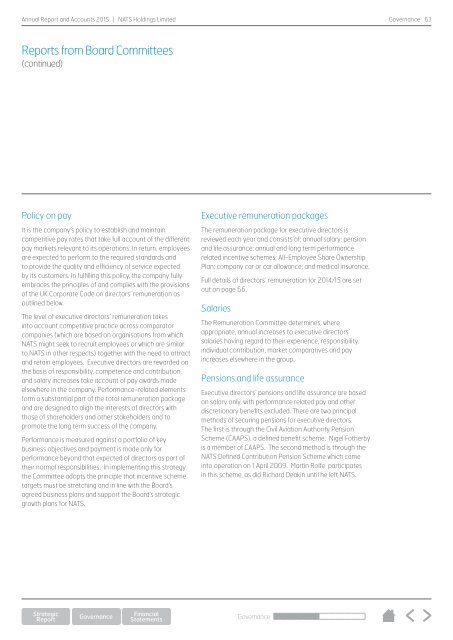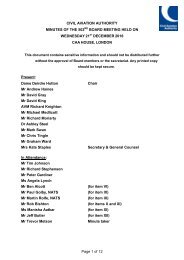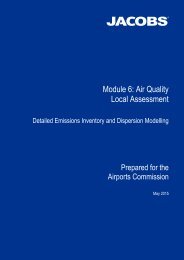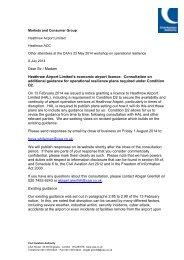NATS-Annual-Report-2015
NATS-Annual-Report-2015
NATS-Annual-Report-2015
You also want an ePaper? Increase the reach of your titles
YUMPU automatically turns print PDFs into web optimized ePapers that Google loves.
<strong>Annual</strong> <strong>Report</strong> and Accounts <strong>2015</strong> | <strong>NATS</strong> Holdings Limited<br />
Governance 63<br />
<strong>Report</strong>s from Board Committees<br />
(continued)<br />
Policy on pay<br />
It is the company’s policy to establish and maintain<br />
competitive pay rates that take full account of the different<br />
pay markets relevant to its operations. In return, employees<br />
are expected to perform to the required standards and<br />
to provide the quality and efficiency of service expected<br />
by its customers. In fulfilling this policy, the company fully<br />
embraces the principles of and complies with the provisions<br />
of the UK Corporate Code on directors’ remuneration as<br />
outlined below.<br />
The level of executive directors’ remuneration takes<br />
into account competitive practice across comparator<br />
companies (which are based on organisations from which<br />
<strong>NATS</strong> might seek to recruit employees or which are similar<br />
to <strong>NATS</strong> in other respects) together with the need to attract<br />
and retain employees. Executive directors are rewarded on<br />
the basis of responsibility, competence and contribution,<br />
and salary increases take account of pay awards made<br />
elsewhere in the company. Performance-related elements<br />
form a substantial part of the total remuneration package<br />
and are designed to align the interests of directors with<br />
those of shareholders and other stakeholders and to<br />
promote the long term success of the company.<br />
Performance is measured against a portfolio of key<br />
business objectives and payment is made only for<br />
performance beyond that expected of directors as part of<br />
their normal responsibilities. In implementing this strategy<br />
the Committee adopts the principle that incentive scheme<br />
targets must be stretching and in line with the Board’s<br />
agreed business plans and support the Board’s strategic<br />
growth plans for <strong>NATS</strong>.<br />
Executive remuneration packages<br />
The remuneration package for executive directors is<br />
reviewed each year and consists of: annual salary; pension<br />
and life assurance; annual and long term performance<br />
related incentive schemes; All-Employee Share Ownership<br />
Plan; company car or car allowance; and medical insurance.<br />
Full details of directors’ remuneration for 2014/15 are set<br />
out on page 66.<br />
Salaries<br />
The Remuneration Committee determines, where<br />
appropriate, annual increases to executive directors’<br />
salaries having regard to their experience, responsibility,<br />
individual contribution, market comparatives and pay<br />
increases elsewhere in the group.<br />
Pensions and life assurance<br />
Executive directors’ pensions and life assurance are based<br />
on salary only, with performance related pay and other<br />
discretionary benefits excluded. There are two principal<br />
methods of securing pensions for executive directors.<br />
The first is through the Civil Aviation Authority Pension<br />
Scheme (CAAPS), a defined benefit scheme. Nigel Fotherby<br />
is a member of CAAPS. The second method is through the<br />
<strong>NATS</strong> Defined Contribution Pension Scheme which came<br />
into operation on 1 April 2009. Martin Rolfe participates<br />
in this scheme, as did Richard Deakin until he left <strong>NATS</strong>.<br />
Governance






